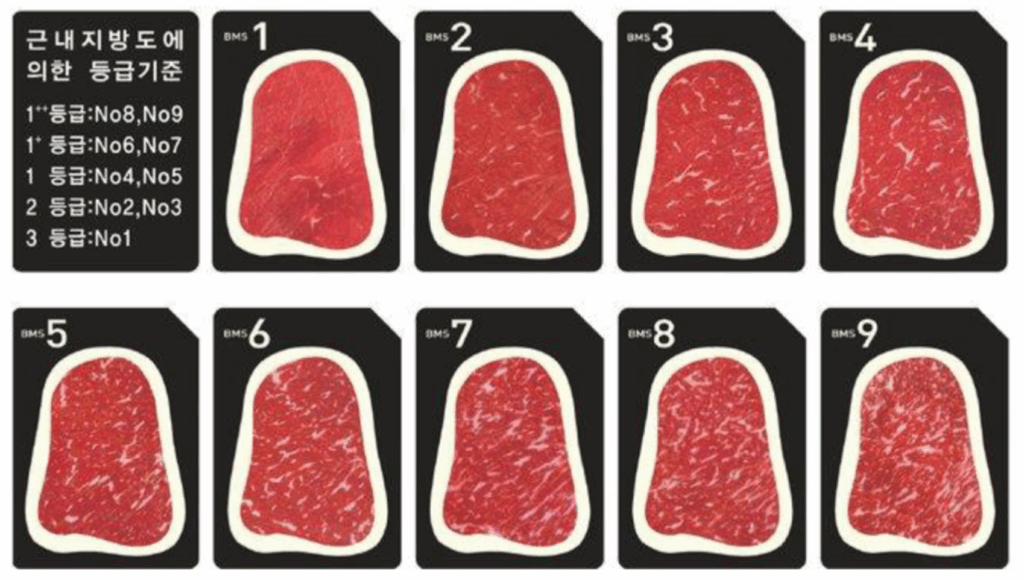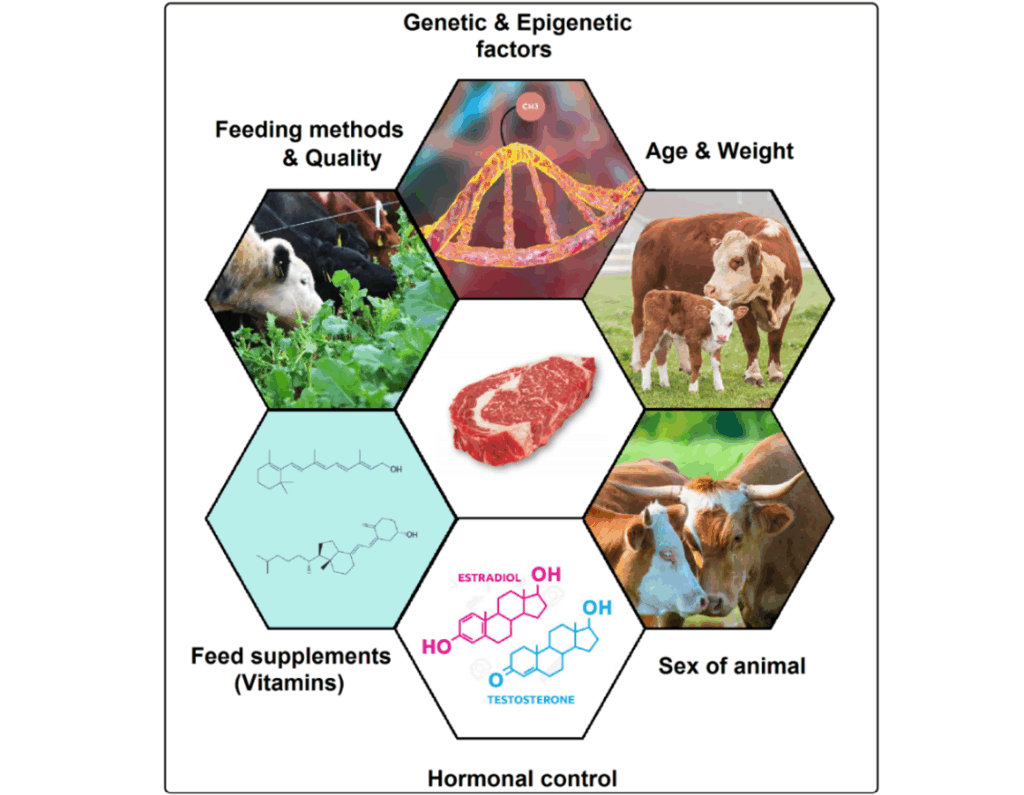Marbling in beef is formed by the intramuscular fat (IMF) content of the muscle tissue, which significantly influences the sensory properties and quality of the meat, including tenderness, juiciness, flavour, and colour. The development of IMF in cattle begins approximately six months after conception and steadily increases throughout the animal’s lifetime. During foetal development and postnatal growth, adipogenesis and lipogenesis are regulated by various factors and genes. Marbling is affected by breed, sex, genetics, heredity, the cow’s nutrition during pregnancy, the feeding of roughages and concentrated energy feeds, their proportions, and the supplementation or deficiency of vitamins A, C, and D. Other influencing factors include castration, early weaning, and these practices combined with high-energy feed strategies. Different management and feeding strategies have been developed to improve IMF accumulation, and combining these approaches can result in significant improvements in IMF deposition. Genetic, management and especially nutritional factors are the primary influences on the IMF content of beef.
Beef has been an essential part of human nutrition since ancient times. Today, in Anglo-Saxon countries, the per capita annual beef consumption exceeds 35 kg, while in the European Union, the average reaches 25 kg. In Hungary, the annual per capita meat consumption is approximately 50-52 kg, with beef accounting for about 10-11 kg; in the Transylvanian region (Romania), this figure is even more modest, barely reaching 5 kg. Despite this, beef production has a strong tradition. In the Middle Ages, the Carpathian Basin was considered a supplier of beef to Europe (Horn, 2013; Horn & Stefler, 2017; Stefler & Mihalecz, 2020). Several factors contributed to the decline of beef production in Hungary and the Carpathian Basin at that time. These include social and economic changes, wars, economic crises, and restructuring of land use, all of which significantly reduced pasture areas. Additionally, population decline also contributed to the decreased demand for beef (Pogácsás, 2012).
The quality of beef is primarily influenced by marbling and intramuscular fat content (IMF), alongside protein content. IMF refers to the visible fat within the muscle tissue, located between muscle fibres. Marbling manifests as white flecks or streaks visible on the cross-sectional surface of the meat, which are caused by fat deposits between muscle fibres (Lee et al., 2018; Nguyen et al., 2021). The IMF content in meat determines its flavour, taste, and tenderness; increased marbling positively affects sensory properties such as juiciness, colour, tenderness, and flavour. Due to its higher content of polyunsaturated fatty acids (PUFA), IMF is considered healthier for humans, prompting numerous recent studies aimed at improving marbling in ruminant meat (Nguyen et al., 2018; 2021; Ladeira et al., 2018; Chen et al., 2019). In Japan, Australia, and South Korea, the marbling score (MS) is the most important parameter used to assess beef quality.
To identify the levels of marbling, the following criteria were established: Low marbling is characterized by little visible fat between muscle fibres, with meat colour being light red or pink, typical of leaner meats. Moderate marbling features visible fat deposits between muscle fibres that do not extend throughout the entire meat mass. The meat colour is bright red, with fat appearing white or pale yellowish. High marbling shows fat integrated throughout the surface of the meat, which may be darker red in colour (Cheng et al., 2015; Baik et al., 2023). Therefore, the degree of marbling can also be inferred from the meat’s colour, which in practice can be assessed by comparing it to a colour scale. Light pink indicates lean meat with little marbling, average red corresponds to moderately marbled meat, while darker red or crimson indicates richly marbled meat with high fat content. In cases of extremely rich marbling, the fat’s white or slightly yellowish-white colour is visible throughout, characteristic of the highest-quality, premium meats (Nguyen et al., 2018, 2021; Chen et al., 2019). Figure 1 shows the grades of marbled meat of Hanwoo.

Figure 1. The scores of Hanwoo marbled meat (Jo et al., 2012; Chung et al., 2018; Innocencio et al., 2023)
Marbling develops mainly through the hypertrophy (increase in cell size) and hyperplasia (increase in cell number) of IMF cells, processes that occur throughout the animal’s life. Foetal and neonatal IMF cell hyperplasia are essential, followed by the hypertrophy of IMF cells in later life stages. The deposition of IMF in beef cattle is complexly influenced by genetics, nutrition, and management practices. Therefore, understanding the mechanisms of adipogenesis (formation of fat cells from preadipocytes) and lipogenesis (synthesis of fat from carbohydrates in adipose tissue or other tissues) is crucial for increasing IMF deposition and improving beef marbling levels (Wang et al., 2009; Nguyen et al., 2021).
In summary, adipogenesis is the process of fat cell formation, during which preadipocytes, or immature fat cells, differentiate into the adipocytes found in adult tissues. Adipogenesis involves the differentiation and development of fat cells. This process is part of lipogenesis, which refers to the accumulation of fat (triglycerides) within fat tissues.
According to Nguyen et al. (2021), factors affecting marbling in beef cattle can be categorized into three groups: genetics (breed, genes, inheritance), sex of the animal, nutrition (prenatal nutritional programming, concentrate-to-forage ratio, vitamins), and management practices (castration, age at weaning, age and weight at slaughter).
The first intramuscular fat (IMF) cells develop in the foetus around day 180 of gestation, and the hyperplasia of IMF cells continues until day 250. In contrast, in other fat cells, hyperplasia occurs after early growth, either during the post-weaning period or in the neonatal stage (Ladeira et al., 2018). This difference provides an opportunity to stimulate IMF cell formation without increasing overall fat accumulation in the carcass. During this period, intramuscular adipogenesis is especially active, leading to more IMF deposition and increased marbling levels (Taga et al., 2011).
In IMF accumulation (from day 250 until slaughter), hypertrophy (cell size increase) plays a more significant role than hyperplasia. Intramuscular fat cells continue to grow during the later stages of finishing, whereas the growth of other fat cell types is slow or ceases. For the production of high-quality beef with desirable marbling, animals with high marbling potential are fed in a way that promotes enlargement of fat cell size and increases the amount of IMF between muscle fibres (Du et al., 2017; Nguyen et al., 2021).
Adipogenesis is a complex, tightly regulated process involving two distinct phases: the transformation of mesenchymal stem cells (MSC) into preadipocytes, and adipogenic differentiation. Lipogenesis, the process of endogenous fatty acid (FA) synthesis, is regulated by various factors (Csapó, 2004). Fat synthesis begins either through de novo FA synthesis or by uptake of dietary fatty acids, followed by triglyceride synthesis, which is then incorporated into adipose tissue. The extent of fat synthesis in animals is primarily influenced by their diet. In ruminants, precursors for FA biosynthesis include acetate and glucose; subcutaneous fat cells preferentially utilize acetate, while intramuscular fat cells use glucose for fat production (Csapó, 2004; Du et al., 2015).
FA uptake into cells is facilitated by various proteins, including fatty acid translocases, fatty acid transport proteins, and fatty acyl-CoA synthetase-related fatty acid-binding proteins (Ladeira et al., 2016). De novo FA synthesis involves enzymes such as acetyl-CoA carboxylase and fatty acid synthase (FAS). Subsequently, FA can be converted into unsaturated fatty acids via stearoyl-CoA desaturase (SCD). During lipolysis, FA are transported into mitochondria via the carnitine-palmitoyltransferase enzyme as acylcarnitine, then reconverted into acyl-CoA, which enters β-oxidation for energy production (Csapó, 2004; Nguyen et al., 2017). The synthesis and breakdown of fatty acids influence IMF deposition: increased lipogenesis and FA uptake, along with decreased lipolysis, result in greater IMF accumulation.
In foetal, neonatal, and early post-weaning stages, nutritional status significantly affects adipogenesis and the number of fat cells stored in adipose tissue. Proper feeding during pregnancy and ensuring the dam’s nutritional needs are maximized can increase the potential for IMF biosynthesis in the foetus (Du et al., 2013; Nguyen et al., 2021).
The main factors affecting the marbling of beef from fattening cattle are: nutrition, including the optimal provision of nutrients during the foetal period to establish marbling; the ratio of concentrated feeds to roughage during the fattening process; adequate supply of proteins and energy; vitamin intake, especially vitamins A, C, and D. Genetic factors also play a significant role, including breed, specific genes, and heritability, as well as the sex of the cattle. Lastly, technological factors, such as castration, age at weaning, slaughter age, and body weight, influence marbling (Schmidt, 1995, 2003; Nguyen et al., 2021).
In many countries around the world, beef cattle husbandry is fundamentally dependent on grazing. Pasture-based beef production, relying on grazing land and crop by-products, can be carried out with minimal investment. The longer the grazing period and the shorter the feeding season based on harvested feed, the higher the likelihood that beef production will be profitable (Horn & Stefler, 2017; Stefler & Mihalecz, 2020).
Pasture-based beef husbandry also plays an important role in landscape and environmental conservation, helping to maintain ecological balance. Without grazing, the condition of grasslands deteriorates, with increased dominance of weeds and invasive species, making the pastures less useful and leading to a decline in local fauna. Conversely, overgrazing also threatens grassland health. Maintaining balance requires conscious livestock management and farming strategies (Schmidt, 2003; Horn & Stefler, 2017; Stefler & Mihalecz, 2020). Figure 2 shows the main biological factors of marbling (Tan & Jiang, 2024). Table 1 shows a summary of beef quality and yield characteristics (Baik et al., 2023).

Figure 2. The main biological factors of marbling (based on (Tan & Jiang, 2024))
Table 1. Summary of beef quality and yield characteristics
| Criteria | Items or indicators |
| Beef-quality characteristics | |
| Marbling | Marbling score, marbling size (fine, coarse) |
| Physiochemical traits | pH, cooking loss, shear force, meat colour, fat colour, texture, maturity |
| Sensory traits | Tenderness, flavour, juiciness, taste, odour, appearance, overall acceptance |
| Beef-quantity characteristics | |
| Yield traits | Carcass weight, eye muscle area, backfat thickness |
| Other considerations | |
| Economic efficiency | Income |
| Social consideration | Rural development |
| Environmental consideration | Carbon footprint, animal welfare |
| Safety issue | Antibiotic |
Leave a Comment: